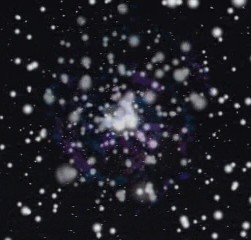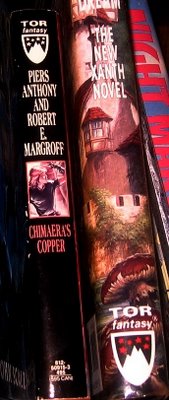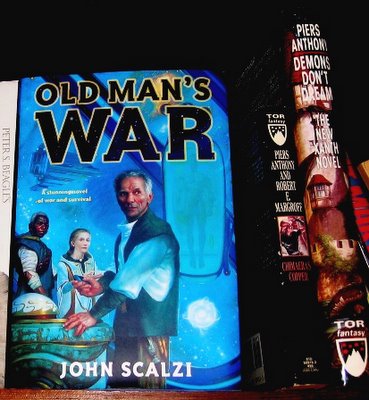Fair warning: this is a long one.
Okay, so I got sidetracked. Instead of reposting more of my
Musings archive, or putting away the stack of laundry I missed yesterday, I spent the day...
- At church (that was always on the schedule);
- Researching fantasy book imprints at Barnes & Noble;
- Exploring the pros and cons of FeedBlitz vs. Bloglet;
- Fiddling with Frappr;
- Marveling at a friend's worldbuilding; and mostly
- Reading about the fantasy genre, editors (and predators), agents, etc. online.
I'll explain all of these. Yes, it's another one of
those entries.
 Church.
Church. The two unusual things about church today were 1) my need not to kneel on my injured knee and 2) a thank you meal afterwards, ostensibly for church volunteers. The first situation was a tricky one, because I was scheduled to "torch" at Mass today. This means I was to carry a candle on a pole, instead of my usual task of carrying a cross on a much longer pole as crucifer. The problem was this: the two torches must kneel on the carpet in front of the altar during the Eucharistic Prayer. And I knew my knee wasn't up to it.
So we played a fairly intensive game of musical acolytes. Colby, filling in, was crucifer, but during the Eucharistic Prayer he would torch. Annie would torch, and then serve (help the celebrant before the Eucharistic Prayer by handing him stuff), and then torch some more. I don't think she realized that third part was the plan until Colby proffered the candle at her. If she hadn't taken it, I'd have knelt on the carpet myself. Ow! Ow! Ow! As it was, I cushioned my knee with three pillows, off to the side where the crucifer normally kneels (on one pillow) during that prayer.
It still hurt.
Afterward, we had the catered meal for volunteers in the Parish Center. As I'd suspected, the whole parish turned up to eat it - at least, everyone who normally attends Coffee Hour after the 10 o'clock, plus a few more. There were blitzes and French toast with strawberries, fresh fruit and heart-shaped sausage, and spiked and unspiked cranberry drinks. A good time was had by all--except the caterer, of course, who ran out of blintzes.
Tor, and Baen, Wizards and Vampires. Then Kevin, Jan (another sf/fantasy-reading parishioner) and I went to Barnes & Noble. I was there to look at the spines of lots and lots of books in the fantasy and science fiction section, and again in the Young Adult (or Teen) section. I was leaning toward Baen as the publisher I'd try next with my
Heirs of Mâvarin submission, but the vast majority of Baen books I saw were sf. The Baen fantasy titles were mostly by big names in the field. Tor, on the other hand, had lots and lots of both sf and fantasy titles. So did DAW. Ace, Spectra, and Del Rey don't take unagented submissions, so I didn't look at those as much.
The trends I saw included lots of humorous fantasy, urban fantasy, many vampires and vampire hunters (especially female ones), and the usual dark destiny of the young king/ princess/ wizard/scullery maid who must save the world from the last of the Old Ones. I did see one or two titles that were still deeply derivative of Tolkien, but most were not. Then I checked out the YA/Teen section, and found lots of teenaged magicians and a few warriors, ghosts and friends of ghosts. I didn't see any YA Baen titles, but I did find the Tor Teen imprint. Hmm, my survey definitely was swinging me back toward Tor instead of Baen.
FeedBlitz and Bloglet. As I believe I mentioned last night, I've added a Bloglet alert subscription thingy to my sidebar here, right under the FeedBlitz one. I initially messed up my Bloglet feeds, by believing a help screen when it said I didn't have to enter my Blogger password. I did. It's fixed now.
Meanwhile, one person that I know about was utterly unable to get FeedBlitz to work for her. Carly and I both tried and failed to help with this, so ultimately the person went with Bloglet instead. We still don't know what went wrong, but a step-by-step explanation my be helpful:
For FeedBlitz: if you put your email address in the little box:
Receive new entries by email:
...you'll be taken to a screen that seems to promise that you only need "one last step," namely entering the letter salad into a word verification box. However, if you're not already a FeedBlitz registered user, this does not appear to work when you try it. You need to register in the upperrighthandd corner of the screen. You'll set up a password to go with your email address, after which you can subscribe to anything that has a feed, including Blogger, AOL, and pretty much any other blog in existence. (National Weather Service pages don't seem to work, though.) The blog owner doesn't even have to register for this to work.
Once you subscribe, you get an email every night that looks something like this:

Here Are Your FeedBlitz Blog Updates
Here are the FeedBlitz updates for mavarin@aol.com
...followed by that new entry, and any other entries posted that day to your chosen blogs.
One thing to note: if I re-edit an entry five times, as I often do, FeedBlitz doesn't send you five versions of it. You get one - probably the version it finds when it polls the blogs for its nightly email.
Bloglet:
This work similarly to the FeedBlitz, but some find it easier to follow. There is some question whether you can subscribe to something a blog owner hasn't specifically made available. Also, I'm waiting to find out whether Bloglet sends you a second version of an entry if it gets updated on a later date. If it does, this is a useful feature for people who want to keep track of the
Round Robin Photo Challenges blog. The RRPC entries are only posted once every two weeks, but are repeatedly updated around the Challenge date.
Frappr. I got an email today from Frappr, telling me that someone with a screen name I'd never heard of "would like to be your friend and join your Friend Map." I checked out the profile. It appears to be a commercial concern, with products I wouldn't buy. The profile mentioned time travel, as does mine; that's how the person probably found me. It also mentioned porn, which mine decidedly does not! So I rejected the request. If you're the person who tried to do this, and you legitimately read and enjoy this blog, contact me directly and I'll reconsider.
Meanwhile, though, I have this
Frappr profile, which I set up weeks ago while trying in vain to get a virtual push pin onto someone else's map. Nobody's been there except me, and possibly this Down person. But it's got pictures, preferences, a quote from
Heirs, and a map with only one pin in it. But you won't let me languish alone for long, will you? Please say you'll be my friend, or at least a pin on my map!
Add yourself to my Frappr map! (Note: this doesn't work right for some reason.)I also added my pin to a
Whedonverse group.
Worldbuilding. A friend of mine is now over 84,000 words, if memory serves, into a fantasy novel she's been writing since about November, based on notes she made for an idea she had years ago. Tonight she was IMing me lots and lots of detail about the history and species of the world of her novels. She also has a bunch of maps she drew for reference. Honestly, the worldbuilding she's done for her books is much more extensive than mine. In a way I need less, because she's got many magical creatures and humanoids to track, whereas I just have the species found in our reality, plus tengremen, and maybe a plant or two. But "worldbuilding" is an important past of the fantasy and science fiction writing process. Someone said at Clarion that in any fiction, you have to either create your own world or, at the very least, some fictional space inside the mostly real one. Even if your lead character lives in a New York City apartment, he or she lives in a fictional apartment, probably with a fictional neighbor across the hall, and a fictional doorman downstairs.
But we probably know what that fictional apartment would be like, so the work in creating it is fairly minimal. Even a western will probably pass muster if you don't make any major errors, such as having someone ride a horse from Tombstone to Tucumcari in a day. But if you've got a fantasy realm for your characters to live in, worldbuilding is crucial, because your readers don't know what the place is like unless you tell them. Is there magic? Who can use it, and how does it work? Is it a resource that gets used up? Does the magician need to rest after expending energy on a spell? What are the major religions? What is the climate? How many continents are there, and how many moons in the sky? There are tons of questions like this to be answered, even if some of it never gets onto the page. Here's a good resource on the subject:
Patricia C. Wrede's Fantasy Worldbuilding QuestionsPatricia is a (mostly YA) fantasy writer with great sense of humor and excellent advice about the craft of writing. She used to hang out on the SF/F writers' boards on AOL, but those days are long gone.
Other Fantasy Writers' Resources Online. I haven't actually looked Patricia's's questions today, but I've been on lots of other sites that had to do with fantasy writing, sf and fantasy publishing, agents and scams. The
Tor FAQ actually had me giggling, repeatedly. It's also full of great information about publishing in general. It was written by Patrick and/or Teresa Nielsen Hayden, of Tor Books and
Making Light fame. I'm guessing the funny bits are mostly Teresa. Here's a sample:
Production schedules
From manuscript to hardcover normally takes about nine months. This process can be speeded up under special circumstances, but it's hard on our dilithium crystals.
One thing that cheered me up considerably was a paragraph about Epic Fantasy, which seems to correspond to the term High Fantasy:
Epic Fantasy
Some of you have noticed certain points of similarity between one and another epic fantasy series -- some that we've published, some published by other houses, and some that first saw light of print a half-century ago. They wonder what's going on.
Here's one of the many possible answers: writers of epic fantasy are frequently drawing on similar bodies of myth, legend, and antecedent literature. This means you can find echoes and similarities in their works, if you set yourself to look for them. But that's not the point. Epic fantasy characteristically produces its effects not so much by the novelty of its invention as by its depth of insight and strength of execution.
Your answers may vary.
The reason I am heartened by this is that Heirs of Mâvarin uses a very common trope in fantasy fiction, "hidden royalty." If you've read or watched much fantasy at all, you've seen this before. Brier Rose (Sleeping Beauty) grows up with three kindly but eccentric ladies, unaware that she's the only child of the king and queen. That scruffy ranger in the corner, Strider, will someday be crowned King Aragorn of Gondor. An Assistant Pig-Keeper, Taran, will someday be High King. The poor boy who's befriended by a talking horse is the lost heir to the throne of Archenland. And yes, a couple of teenagers who work in a Liftlabeth stable will soon learn they're Princess Cathma and Prince Carli of Mâvarin.
I'm so embarrassed!
You see, a major problem with the fantasy genre is that virtually all fantasy writers grew up reading Tolkien and Lewis. There is older fantasy than
The Lord of the Rings, but that's the book that really got the ball rolling for this kind of story. In the 1970s, most fantasy novels seemed to involve a young person of mysterious parentage whose destiny is to undertake a quest with a diverse group of friends and allies, and save the entire world from an ancient, overpowering evil. Along the way they were almost sure to encounter unicorns, elves, dwarfs and dragons.
But people got tired of reading third-rate Tolkien clones, and the genre diversified. For a while in the 1980s and early 1990s, postmodern fantasy, which cynically made fun of fantasy clichés, was more common than the sincere stuff. There was urban (contemporary) fantasy, which involved elves and dragons and such in something like our modern world; and there were pun-filled romps, set in a fantasy realm but with sly references to modern life.
And then things changed again, and we got more diversity. There's still urban fantasy, and humorous fantasy, and high fantasy in the Tolkien tradition, but it shares the shelves with vampire stories and stories based on the folklore or China or India or Africa, and books that have no identifiable dragons or elves at all. The idea these days is to avoid the worn-out fantasy conventions as much as possible. The other night, I saw a website that gave a failing grade to anything that had even one element on a long list of fantasy clichés. By that standard,
Heirs fails. It has not only hidden royalty, but also a young person who comes from humble circumstances, undertakes a quest and ends up wielding great power. Well, actually, that's just one of the hidden royalty kids again.
But as
Wikipedia points out,
"the use of such particular themes and ideas is the very thing that distinguishes high fantasy from its fellow subgenres, and that a sufficiently unique example of high fantasy would be more likely to be placed in a different subgenre altogether, thus rendering accusations of unoriginality somewhat circular."
So how is a fantasy writer supposed to proceed? If there are too many fantasy tropes (elements characteristic of the fantasy genre), then it's unoriginal hack work. If it hasn't any, then it's not fantasy at all - or, at least, not High Fantasy. So is my use of the hidden royalty trope good or bad, or neither? Does it make the whole book derivative, or is it merely a feature that marks it as part of the genre, a type of storytelling that draws heavily on archetypal and mythic themes?
Judging from what I've read over the past week, most people who write about the genre seem to agree that too much aping of Tolkien or European folktales is probably a bad thing, but that it's virtually impossible to have fantasy without any traditional fantasy elements whatsoever. The key seems to be to avoid filling your book with stock characters and situations, select a few fantasy elements that are integral to the story you want to tell, and tell that story as well as possible, incorporating other elements that readers haven't seen before - or, at least, not often. In his Submission Guidelines, Jim Baen acknowledges this when he says, "overall the work must at least strive for originality."
Oh, I'm striving, all right. Have been all along.
But I still have hidden royalty. That's one of the key elements of the book. I wanted the news that they're not who they thought they were to actually make a difference in who these characters are, rather than be a tacked-on reward at the end of the story. It's a fairly original treatment of the hidden royalty trope. I hope.
Maybe Patrick and Teresa Nielsen Hayden won't mind that part so much, once they get a look at Rani.
'Cause I think my three-chapters-and-synopsis are going to Tor.
Karen
*****
Update:Nobody can get to a page that lets you add pushpins to my map. Frapper won't even let me get to the email invitation page. I sent them a support request.
I have yet to receive a single email from Bloglet.
And I have to struggle to force spaces between words. Half the time when I use the spacebar, the computer either hesitates or ignores it.
Sometimes technology sucks.
I'm rebooting. For whatever good it will do.
 (Photo added Tuesday at work.)
(Photo added Tuesday at work.)





































